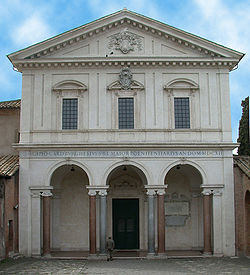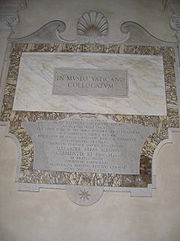
San Sebastiano fuori le mura
Encyclopedia

Basilica
The Latin word basilica , was originally used to describe a Roman public building, usually located in the forum of a Roman town. Public basilicas began to appear in Hellenistic cities in the 2nd century BC.The term was also applied to buildings used for religious purposes...
in Rome
Rome
Rome is the capital of Italy and the country's largest and most populated city and comune, with over 2.7 million residents in . The city is located in the central-western portion of the Italian Peninsula, on the Tiber River within the Lazio region of Italy.Rome's history spans two and a half...
, central Italy
Italy
Italy , officially the Italian Republic languages]] under the European Charter for Regional or Minority Languages. In each of these, Italy's official name is as follows:;;;;;;;;), is a unitary parliamentary republic in South-Central Europe. To the north it borders France, Switzerland, Austria and...
. Up to the Great Jubilee
Great Jubilee
The Great Jubilee in 2000 was a major event in the Roman Catholic Church, held from December 24, 1999 to January 6, 2001. Like other previous Jubilee years, it was a celebration of the mercy of God and forgiveness of sins...
of 2000, San Sebastiano was one of the Seven Pilgrim Churches of Rome
Seven Pilgrim Churches of Rome
The Seven Pilgrim Churches of Rome are seven churches in Rome, which are visited by pilgrims in order to gain indulgences. The churches include the four patriarchal basilicas:*San Pietro in Vaticano*San Giovanni in Laterano*San Paolo fuori le mura...
, and many pilgrims still favor the traditional list.
History
Built originally in the first half of the 4th century, the basilica is dedicated to St. Sebastian, a popular Roman martyr of the 3rd century. The name ad catacumbas refers to the catacombs of St Sebastian, over which the church was built, while "fuori le mura" refers to the fact that the church is built outside the Aurelian WallsAurelian Walls
The Aurelian Walls is a line of city walls built between 271 and 275 in Rome, Italy, during the reign of the Roman Emperors Aurelian and Probus....
, and is used to differentiate the basilica from the church of San Sebastiano al Palatino
San Sebastiano al Palatino
San Sebastiano al Palatino is a basilica church in Rome. It is devoted to Saint Sebastian, and is located on the Palatine Hill.According to legend, it is built on the site of its dedicatee's martyrdom, with the first church constructed in the 10th century, and the second church being the result of...
on the Palatine Hill
Palatine Hill
The Palatine Hill is the centermost of the Seven Hills of Rome and is one of the most ancient parts of the city...
. According to the founding tradition, in 258, during the Valerian persecutions
Persecution of Christians
Persecution of Christians as a consequence of professing their faith can be traced both historically and in the current era. Early Christians were persecuted for their faith, at the hands of both Jews from whose religion Christianity arose, and the Roman Empire which controlled much of the land...
, the catacombs were temporarily used as place of sepulture of two other saints martyred in Rome, Peter and Paul
Paul of Tarsus
Paul the Apostle , also known as Saul of Tarsus, is described in the Christian New Testament as one of the most influential early Christian missionaries, with the writings ascribed to him by the church forming a considerable portion of the New Testament...
, whose remains were later transferred to the two basilicas carrying their names: whence the original dedication of the church, Basilica Apostolorum ("Basilica of the Apostles"). The dedication to Sebastian dates to the 9th century.
Sebastian's remains were moved here around 350. They were transferred to St. Peter's
St. Peter's Basilica
The Papal Basilica of Saint Peter , officially known in Italian as ' and commonly known as Saint Peter's Basilica, is a Late Renaissance church located within the Vatican City. Saint Peter's Basilica has the largest interior of any Christian church in the world...
in 826, fearing a Saracen
Saracen
Saracen was a term used by the ancient Romans to refer to a people who lived in desert areas in and around the Roman province of Arabia, and who were distinguished from Arabs. In Europe during the Middle Ages the term was expanded to include Arabs, and then all who professed the religion of Islam...
assault: the latter, in fact, materialized, and the church was destroyed. The building was refounded under Pope Nicholas I
Pope Nicholas I
Pope Nicholas I, , or Saint Nicholas the Great, reigned from April 24, 858 until his death. He is remembered as a consolidator of papal authority and power, exerting decisive influence upon the historical development of the papacy and its position among the Christian nations of Western Europe.He...
(858-867), while the martyr's altar was reconsecrated by Honorius III
Pope Honorius III
Pope Honorius III , previously known as Cencio Savelli, was Pope from 1216 to 1227.-Early work:He was born in Rome as son of Aimerico...
(1216-1227), by request of the Cistercians, who had received the place. In the 13th century the arcade of the triple nave was walled in.
The current edifice is largely a 17th-century construction, commissioned by Cardinal Scipione Borghese
Scipione Borghese
Scipione Borghese was an Italian Cardinal, art collector and patron of the arts. A member of the Borghese family, he was the patron of the painter Caravaggio and the artist Bernini...
in 1609 from Flaminio Ponzio
Flaminio Ponzio
Flaminio Ponzio was an Italian architect during the late-Renaissance or so-called Mannerist period, serving in Rome as the architect for Pope Paul V.Ponzio was born in Viggiù near Varese, and he died in Rome...
and, after Ponzio's death in 1613, entrusted to Giovanni Vasanzio
Giovanni Vasanzio
Giovanni Vasanzio or Jan van Santen was a Dutch-born architect, garden designer and engraver who spent his mature career in Rome, where he arrived in the 1580s...
, who completed it.
Overview

Antonio Giorgetti
Antonio Giorgetti was an Italian sculptor who passed his career in Rome, a disciple of Gian Lorenzo Bernini...
. The Relics Chapel directly across the nave
Nave
In Romanesque and Gothic Christian abbey, cathedral basilica and church architecture, the nave is the central approach to the high altar, the main body of the church. "Nave" was probably suggested by the keel shape of its vaulting...
houses a stone carrying the alleged footprints of Jesus related to the episode of "Quo vadis?
Quo vadis
Quo vadis? is a Latin phrase meaning "Where are you going?" or "Whither goest thou?" The modern usage of the phrase refers to Christian tradition, related in the apocryphal Acts of Peter , in which Saint Peter meets Jesus as Peter is fleeing from likely crucifixion in Rome...
" in the apocryphal Acts of Peter
Acts of Peter
The Acts of Peter is one of the earliest of the apocryphal Acts of the Apostles. The majority of the text has survived only in the Latin translation of the Vercelli manuscript. It is mainly notable for a description of a miracle contest between Saint Peter and Simon Magus, and as the first record...
, one of the arrows which struck St. Sebastian together with part of the column to which he was tied during the martyrdom. Noteworthy is the Albani Chapel, built in 1716 and designed by Carlo Maratta
Carlo Maratta
Carlo Maratta or Maratti was an Italian painter, active mostly in Rome, and known principally for his classicizing paintings executed in a Late Baroque Classical manner. Although he is part of the classical tradition stemming from Raphael, he was not exempt from the influence of Baroque painting...
, Alessandro Specchi
Alessandro Specchi
Alessandro Specchi was an Italian architect and engraver.Born in Rome, he trained as an architect under Carlo Fontana. He also specialized as an engraver and made a well known series of plates for prints of vedute or views of Rome As an architect, he was influenced by Francesco Borromini...
, Filippo Barigioni
Filippo Barigioni
Filippo Barigioni was an Italian sculptor and architect working in the Late Baroque tradition.Bariogioni was born in Rome. His career was spent largely on papal commissions, including aqueducts and fountains, in and around Rome...
and Carlo Fontana
Carlo Fontana
Carlo Fontana was an Italian architect, who was in part responsible for the classicizing direction taken by Late Baroque Roman architecture.-Biography:...
, commissioned by Pope Clement XI
Pope Clement XI
Pope Clement XI , born Giovanni Francesco Albani, was Pope from 1700 until his death in 1721.-Early life:...
and dedicated to Pope Fabian
Pope Fabian
Pope Fabian was Pope from January 10, 236 to January 20, 250, succeeding Pope Anterus.Eusebius of Caesarea relates how the Christians, having assembled in Rome to elect a new bishop, saw a dove alight upon the head of Fabian, a layman and stranger to the city, who was thus marked out for this...
, who was Bishop of Rome during the persecution of Decius. Flanking the altar, busts of Saints Peter and Paul by Nicolò Cordier recall the first dedication of the basilica.

